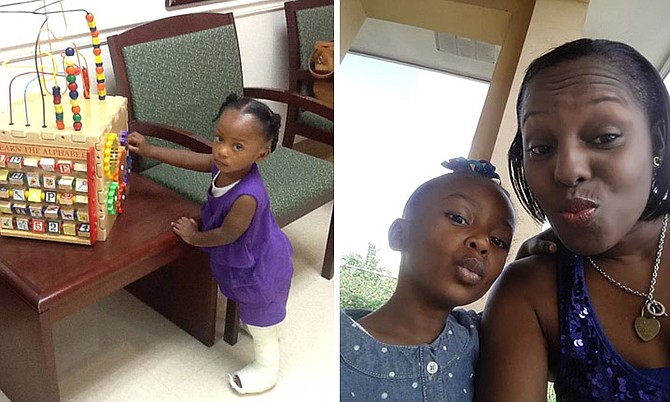By JEFFARAH GIBSON
Tribune Features Writer
jgibson@tribunemedia.net
THE mother of four-year-old Kaylee Thomas, who was diagnosed with having a clubfoot at birth, is engaging in several initiatives to raise awareness of the condition in the Bahamas.
When Kendra Thomas gave birth to Kaylee on June 29, 2010, doctors immediately took the baby away. A few days later when she finally saw Kaylee, the new mother was told that her baby was born with talipes equinovarus, more commonly known as clubfoot – a treatable birth defect.
When clubfoot occurs, the foot is twisted inward and down. This condition occurs during development in the womb. The term clubfoot refers to the way the foot is positioned at a sharp angle to the ankle, like the head of a golf club. Clubfoot is a fairly common birth defect and is usually an isolated problem for an otherwise healthy newborn.
Kaylee has been undergoing treatment since she was a month old to correct her clubfoot The next surgery to reposition her feet will take place in July at Paly Advanced Limb Lengthening Institute at St Mary’s Medical Centre in West Palm Beach, Florida.
According to the Club Foot Bahamas Facebook page, most children born with clubfoot are not missing any bones, muscles or connective tissue. One or both feet may be affected, and the affected feet can range from relatively flexible to stiff and rigid. The condition is not painful for the new born, though when a child gets to walking age, walking with an uncorrected clubfoot can be very painful and difficult, if not impossible.
One method for treating clubfoot requires the use of over-the-knee casts and special protocols. The method consists of using a series of casts, gentle manipulation and the use of a special brace. The treatment is effective and is the most cost effective treatment with no side effects.
In severe cases like Kaylee’s, where manipulation and casting alone will not result in success, surgery is recommended.
Kendra told Tribune Health that although it has been a very challenging journey, Kaylee is progressing greatly.
“We have seen major improvements in Kaylee. We have had relapses, but for the most part she is doing well. Kaylee can walk, but she walks with her feet turned inwards, so her foot overlaps. Sometimes she has it and down pat, but she cannot balance that well. For example, when she stands up she rocks to keep her balance or tries to position her feet to balance herself,” she said.
Kendra said because the condition is not common in the Bahamas, many parents are left shocked, afraid and confused when their children are diagnosed with clubfoot. She said many people mistake the condition for pigeon toes or intoeing, which is a common childhood orthopaedic condition.
“People would say, put the shoe on the child’s feet left and right and that will fix the foot. But that does not fix the problem. So I want to bring awareness because parents do not know what it is.
“When their child is born they feel as though they are lost. They feel like, ‘Why me?’ Clubfoot is nothing like cancer or AIDS in that it is life-threatening, but it is challenging to deal with,” she said.
As part of her effort to raise awareness, Kendra started a clubfoot group and also launched the Club Foot Bahamas Facebook page, which is used as a tool to educate people about the condition and raise awareness.
“A lot of people do not know what clubfoot is. When I am out in public with my daughter some people would ask how her leg got broken because they see the cast,” she said.
“I just want parents who have a child with clubfoot to be encouraged and walk by faith. You are going to see your child in a cast; they are going to cry. But you have to stay strong and be encouraged. It is a journey, but you will see progress at the end of it all.”





Comments
Use the comment form below to begin a discussion about this content.
Sign in to comment
Or login with:
OpenID